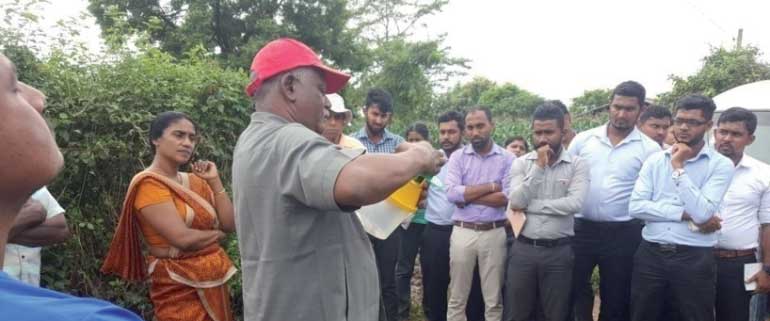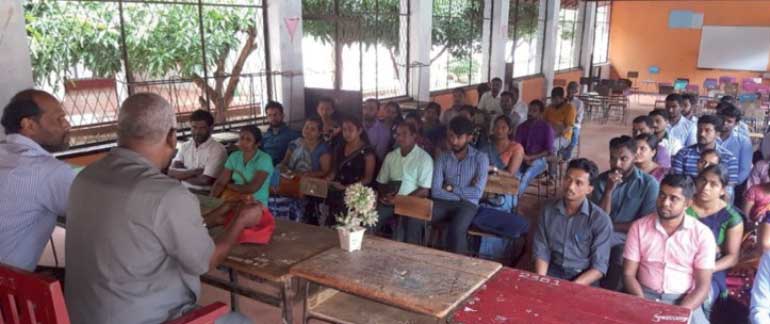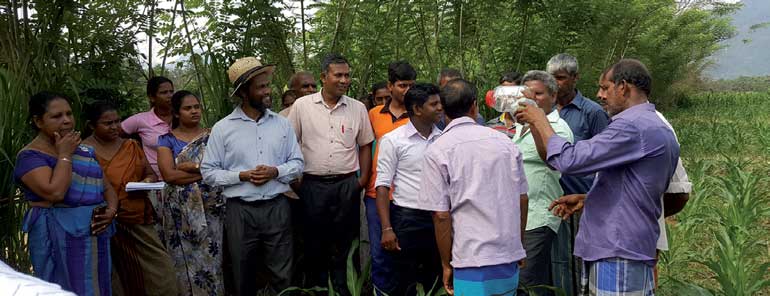Sunday Apr 06, 2025
Sunday Apr 06, 2025
Tuesday, 1 June 2021 03:08 - - {{hitsCtrl.values.hits}}
 Training of trainers on Fall Armyworm monitoring and management
Training of trainers on Fall Armyworm monitoring and management

Establishment of a National FAW Network

Introductory release of egg parasitoid of FAW natural enemies in affected maize fields
The first Geo-Zone Coordination Meeting for the Implementation of the FAO Global Action on Fall Armyworm (FAW) Control in South Asia was hosted by the FAO Asia-Pacific Regional Office recently. Representatives from the Department of Agriculture in Sri Lanka, the FAW Task Force and the FAO Representation in Sri Lanka attended the meeting hosted virtually in Bangkok. Officials from India, Pakistan, Bangladesh and Nepal were also in attendance.
The member countries submitted updates on the implementation of the national programs and response actions that are taken to control the fall armyworm. Updates on the implementation of the FAO Global Action on FAW control worldwide and in the South Asia Geo-Zone were also integral parts of the discussion.
Providing a situation report on FAW control and management in Sri Lanka, the Department of Agriculture stated that when the FAW outbreak was first recorded in 2019, 45,576 hectares out of 68,000 hectares of maize cultivation were affected by the pest and the yield loss was estimated at 16%. However during the last season ending in April this year, out of the total 104,000 hectares of maize cultivated, only 144 hectares were affected by FAW with the yield loss recorded at less than 2%.
“This shows a significant reduction in the FAW infestation last season due to early detection, monitoring and the willingness of a majority of farmers to manage the pest by piloting biological control measures, rather than depending on pesticides,” highlighted Director General of Agriculture Dr. W.M.W. Weerakoon. “Since the inception of the outbreak, FAO has been a partner in FAW control and management. They warned us about possible FAW migration to the country in early 2018 and have shared technical knowledge, lessons learnt and guidance to effectively manage and control FAW ever since.”
The Fall Armyworm (FAW) or Spodoptera frugiperda was first detected in all major maize growing areas in Sri Lanka in October 2018 and the new pest was confirmed as the fall armyworm by the International Plant Protection Convention (IPPC) in January 2019. The pest was also identified in other neighboring countries such as India, Pakistan, Bangladesh and Nepal.
With the confirmation of fall armyworm infestation in Sri Lanka, the Government of Sri Lanka requested assistance from FAO which resulted in the launch of a fall armyworm emergency response program in February 2019, the first such program in South East Asia. The technical cooperation project funded by the Food and Agriculture Organization of the United Nations (FAO) and implemented by the Department of Agriculture has been focusing on enhancing technical capacity for early warning, monitoring and management of fall armyworm in Sri Lanka.
The emergency response in Sri Lanka is aimed at mobilising resources and expertise to enhance national capacities to tackle FAW. This includes visits by FAO international experts who studied the situation on the ground in some of the worst affected areas and advised the Department of Agriculture. The emergency response also reinforces efforts to discourage widespread use of highly hazardous pesticides. Pesticide application was discouraged from the onset of the FAW outbreak and farmers were advised to apply pesticides only when necessary. Immediate steps were also taken to conduct studies and research on local natural enemies of FAW as potential natural control mechanisms.
With the technical assistance of FAO, the Department of Agriculture has been investigating the identification, rearing, multiplication of prominent predators, parasitoids and pathogenic microbial; inoculate and introductory release in affected maize fields and enhancement of the habitat of these natural enemies. The initial observations have shown that the use of these natural enemies are positive and mass breeding of natural enemies have been initiated.
“We know that fall armyworm is here to stay in Sri Lanka and has become one more pest that farmers need to learn about and manage,” said FAO Representative for Sri Lanka and the Maldives Sarat Dash (acting in-charge).
He commended the Department of Agriculture for using existing national platforms and infrastructure to ensure that the information, knowledge and data that is collected makes its way to the farmers who have to manage the pest on the ground. “This empowers farmers to make informed decisions and not resort to unsustainable practices such as the indiscriminate use of pesticides which is harmful for the environment, the natural predators of FAW, and also on human health,” Dash elaborated.
The Fall Armyworm Monitoring and Early Warning System (FAMEWS), a global surveillance system developed by FAO has been translated and adapted to the Sri Lankan context so that it becomes easy to use for farmers and local officials. The FAMEWS mobile application supports all stages of FAW management: to identify the pest, monitor the level of infestation to map its spread, as well as to learn about the important natural enemies and the measures that are most effective in managing Fall Armyworm.
Through the establishment of a National FAW Network, Training of Trainers sessions regarding the use of the FAMEWS application, monitoring and data generation have been conducted for 477 Agriculture Extension Officers across the island. Mobile phones were also distributed by FAO to extension officers and have been used to monitor the FAW distribution pattern and population through the FAMEWS mobile application. FAO distributed pheromone traps which are used to detect the presence and build-up of FAW in a particular area.
A number of communication and awareness materials such as FAO Field guides, and Guidance Notes about FAW Integrated Pest Management (IPM) strategies have been adapted to the local context and shared with the Ministry of Agriculture and the Department of Agriculture in Sri Lanka. These material were in-turn distributed through Farmer Field Schools.
Discover Kapruka, the leading online shopping platform in Sri Lanka, where you can conveniently send Gifts and Flowers to your loved ones for any event including Valentine ’s Day. Explore a wide range of popular Shopping Categories on Kapruka, including Toys, Groceries, Electronics, Birthday Cakes, Fruits, Chocolates, Flower Bouquets, Clothing, Watches, Lingerie, Gift Sets and Jewellery. Also if you’re interested in selling with Kapruka, Partner Central by Kapruka is the best solution to start with. Moreover, through Kapruka Global Shop, you can also enjoy the convenience of purchasing products from renowned platforms like Amazon and eBay and have them delivered to Sri Lanka.
Discover Kapruka, the leading online shopping platform in Sri Lanka, where you can conveniently send Gifts and Flowers to your loved ones for any event including Valentine ’s Day. Explore a wide range of popular Shopping Categories on Kapruka, including Toys, Groceries, Electronics, Birthday Cakes, Fruits, Chocolates, Flower Bouquets, Clothing, Watches, Lingerie, Gift Sets and Jewellery. Also if you’re interested in selling with Kapruka, Partner Central by Kapruka is the best solution to start with. Moreover, through Kapruka Global Shop, you can also enjoy the convenience of purchasing products from renowned platforms like Amazon and eBay and have them delivered to Sri Lanka.